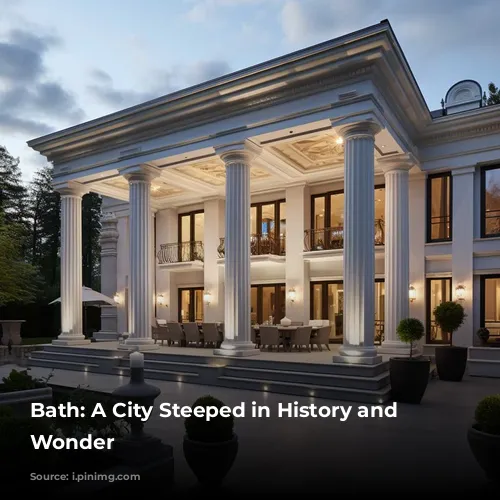Bath, a UNESCO World Heritage Site, is a city brimming with architectural marvels that tell a captivating story spanning centuries. From the ancient Romans to the stylish Georgians, each era has left its mark on this enchanting city.
Roman Origins: Aquae Sulis
Bath’s captivating journey began with the Romans, who, unlike their usual military outposts, established “Aquae Sulis” as a sanctuary of relaxation and healing. In 43 AD, they began developing this haven around natural hot springs, a testament to their appreciation for wellness. By 70 AD, a reservoir had been built around the springs, followed by elaborate bath complexes and a temple dedicated to the goddess Sulis Minerva. The discovery of a temple to Aesculopius, near the Cross Bath, further suggests that healing was a significant aspect of this ancient site. As a religious and bathing center, Aquae Sulis drew visitors from across Britain and Europe, foreshadowing Bath’s future as a prominent tourist destination.
A Legacy of Roman Grandeur
Today, the Roman Baths stand as one of the most well-preserved Roman relics in the world. Each day, a remarkable 1,170,000 liters of steaming spring water, reaching 46°C, fill the ancient bathing site, a testament to the enduring power of these natural wonders.
Georgian Glamour: A Transformation of Bath
The 18th century ushered in a new era for Bath, completely transforming its society, architecture, and history. This period is responsible for much of the city’s contemporary charm and iconic status. Bath boasts a staggering 5,000 listed buildings, offering the most impressive collection of Georgian architecture in the entire country.
Visionaries of Elegance: Shaping Bath’s Identity
Three visionary entrepreneurs, driven by a shared passion for beauty and elegance, set about making Bath a jewel of Europe. Ralph Allen, a former mayor, crafted the serene and intimate Prior Park Landscape Garden. Richard “Beau” Nash, a charismatic figure, propelled Bath to become the most fashionable resort in 18th-century England. John Wood the Elder, an architect of great vision, designed iconic streets and buildings, including the Circus and Queen Square. His son, John Wood the Younger, followed in his father’s footsteps, creating the Assembly Rooms and the majestic Royal Crescent.
The Royal Crescent: A Masterpiece of Georgian Design
The Royal Crescent is a true architectural triumph, composed of 30 elegant houses arranged in a crescent shape. Built between 1767 and 1774, it stands as one of the most outstanding examples of Georgian architecture worldwide. For a taste of authentic Royal Crescent life, visit The Royal Crescent Hotel & Spa, offering luxurious accommodations, opulent amenities, beautiful gardens, fine dining, and a relaxing spa. Or simply indulge in an elegant afternoon tea for a touch of Georgian grandeur.
Step Back in Time: No. 1 Royal Crescent
For a glimpse into the original style of Royal Crescent living, No. 1 Royal Crescent, the first house constructed on the crescent, is open to the public as a museum maintained by the Bath Preservation Trust. The house provides a fascinating look into the opulent furnishings and lifestyles of wealthy property owners in the 18th century. Friendly and knowledgeable guides stationed throughout the house reveal fascinating secrets about its history, former residents, and notable guests.
Bath Stone: The City’s Unique Signature
Bath Stone, an oolitic limestone quarried from the Combe Down and Bathampton Down Mines, gives Bath’s buildings their distinctive honeyed hue. This warm, golden stone has become synonymous with the city’s architectural charm, adding to its captivating allure.
In conclusion, Bath is a testament to the enduring power of history and architectural brilliance. From its Roman origins to its Georgian splendor, each era has left an indelible mark on this captivating city, making it a must-visit for history enthusiasts and architecture lovers alike.
